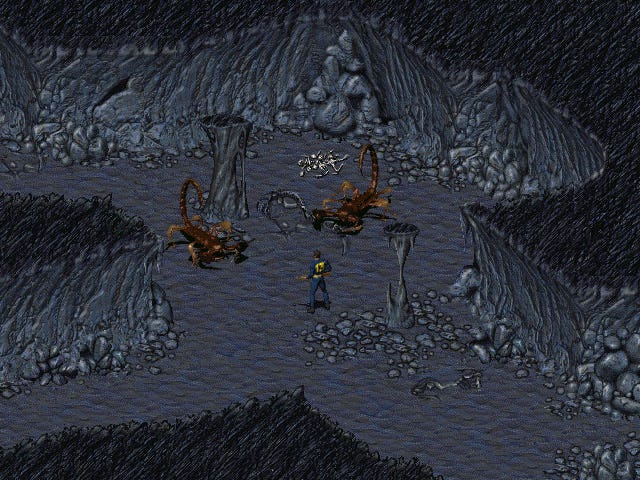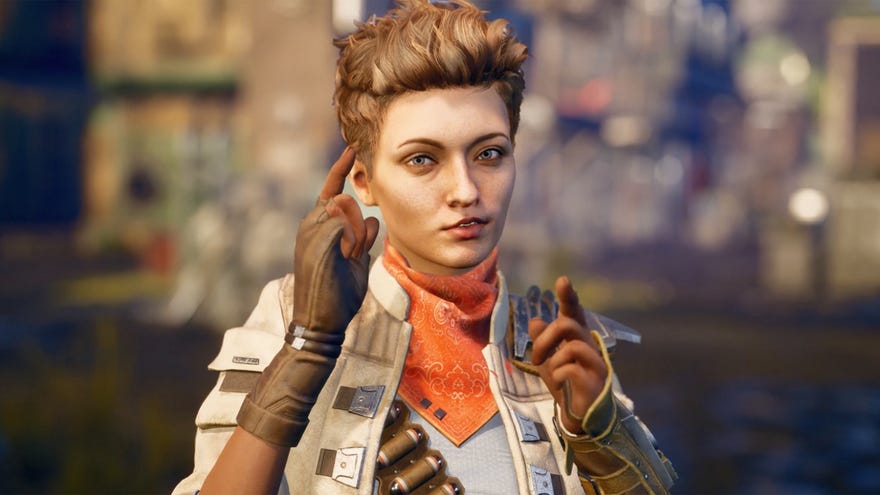Tim Cain has taken his Fallout and The Outer Worlds dev stories to YouTube - and he's having a great time
The semi-retired Cain tells us that “there is so much about being a game director that is not fun”
Tim Cain wrote what is perhaps gaming’s most famous and influential monologue: the introduction to Fallout. “War never changes,” he says. “People loved it. I’m like, ‘I must be a writer.’” Yet much more recently, when Cain sat down to write his memoirs, nobody really liked what came out on the page. “I was really, really bad at it,” he says. “I had half a dozen people read it, and they all pretty much said that the stories were good, but my writing wasn’t.”
Cain’s writing strengths, as fellow Fallout originator Leonard Boyarsky has suggested, lie in shortform. Which was bad news for anyone who wanted to read the definitive account of his four decades at the heart of Interplay, Troika and Obsidian, three of the most important RPG studios of all time. Thankfully, though, it turns out Cain is a natural raconteur. The same anecdotes that appeared flat and toneless in his memoirs go down a storm on YouTube. There, for the past seven months, Cain has been delivering his stories straight to camera, as if at a dinner party with 73,500 other people. “When I started the channel, I would effectively just look at something in the book and be like, ‘I’ll tell that story today,’” he says. “Now I spend as much time answering questions and doing videos based on things people ask about.”
Unintentionally, Cain On Games has become healthy counterprogramming to popular YouTubers who make sweeping assumptions about how game development works. Among Tim’s recent videos are titles like ‘Marketing The Outer Worlds’, ‘Game Production Stages’ and ‘Focus Group Testing’. Cain didn’t realise how much knowledge he was taking for granted - and how fascinated viewers would be by the nitty-gritty.
The videos that have made headlines, however, are the ones that reveal juicy RPG secrets: a proposed trilogy of Vampire - Bloodlines games that Cain forgot about; the elevator pitch of The Outer Worlds as ‘Fallout meets Firefly’; a blow-by-blow account of why Cain left Fallout and Interplay behind. Some of these stories involve professional upsets and bust-ups with bosses. Yet where they get personal or painful, Cain is never less than philosophical - explaining the sequence of events with dispassionate calm rather than the ire of a disgruntled former employee. The smile and twinkle that defines his video thumbnails never slips into jadedness or cynicism.
“I’ve now been doing this so long that the bad stuff is just like bumps along the road,” he says. “I’m not sitting here obsessing about quitting Interplay or Carbine. Time and distance has given me a perspective on what happened.” Time, perspective, and copious notes. Cain developed a taste for note-taking at engineering school, after the photographic memory of his childhood faded. “Sometimes,” he explains, “you’re in a class where the book doesn’t include everything.” The habit then bled over into his games career. At Interplay, Cain would routinely jot down comments from his colleagues, as if recording the minutes of a meeting that never ended. That led to Fallout shipping alongside a file full of quotes from its dev team. Amid the non-sequitors and innuendos is a line from Boyarsky, which simply reads: “Don’t quote me on that.”
Over the years, Cain has kept everything, from the task lists made at Troika so that jobs wouldn’t get forgotten between coding sessions and publisher meetings, to the late-night journals written to document arguments with colleagues. Today, these assorted notes provide material for YouTube.

“Some of them I barely remember,” he says. “Like, I did a whole video on the original names for Fallout.” Thanks to Cain’s notes, we know that on June 19th of 1996, the team at Interplay bundled into a conference room and considered titles including Radstorm, Nuclear Summer, and Hiroshima Revisited. In May last year, Cain stifled his giggles as he ran through the list. “It was funny reading over those. But I didn’t [take those notes] because I thought, ‘25 years from now, this would make a great video.’”
Fallout was an early indicator of the design philosophy that has guided Cain throughout his working life. “I didn’t want a lot of things to be scripted,” he says. “I wanted things to be done systemically.” He still remembers coding the pickpocketing system. “It used the same interface as barter,” he says. “So because of that, automatically, it let you put things in.” In other words, you could reverse-pickpocket. Rather than shutting off that possibility, the Fallout team wrote a quest in which you could plant a recording device on a corrupt casino manager. What they didn’t anticipate was that QA testers would start slipping sticks of dynamite into the pockets of NPCs too.
Initially, the team was worried. “But then we were like, ‘This is fun. It’s an emergent property, why not? Why can’t you set the timer for 60 seconds, stick it in someone’s backpack and sneak away?’”
Just as the magic of Baldur’s Gate 3 is rooted in a full-hearted attempt to capture the open-endedness of Dungeons & Dragons, Fallout is a reflection of the freedom of GURPS, the tabletop system on which it was originally based. It becomes a different game, depending on the skills players invest in and the choices they make in the wasteland. “I didn’t want it to be the same experience for everyone,” Cain says. “In order to do that, we had to just make rules, and then let the rules go wherever they go. Not hard-code it.”
In one early quest, the village elder’s daughter, Tandi, is kidnapped by the Khan raiders. By Cain’s count, there are 12 or 14 distinct ways of resolving that situation. “Only a few of them are scripted,” he says. “The rest are completely systemic, that just come out of the rules of either using explosives, or stealth, or combat. Even I was surprised at how many different ways QA found to rescue Tandi.”
Testers also discovered that if you didn’t take Tandi back to the village of Shady Sands, you effectively got an extra companion tailing you through the game. “So we added dialogue. Whenever you entered a new map, if it wasn’t Shady Sands, occasionally Tandi would plaintively go, ‘Why are we here? What aren’t you taking me home? I’m young and not very experienced, could you please take me back to my family?’”
“Player agency is huge in my games. I don’t necessarily want control.”
It’s an approach which holds player-told stories in higher regard than any bespoke plotline - and which went on to shape the games of Troika, the legendary studio Cain set up with Boyarsky and Jason Anderson. It showed up in Arcanum, The Temple Of Elemental Evil and Vampire: The Masquerade – Bloodlines, even as the systemic side of RPGs slid out of the mainstream. “This isn’t new, but I have noticed it in modern designers, especially narrative designers - they’re afraid to lose control of the game,” Cain says. “But player agency is huge in my games. I don’t necessarily want control.”
That’s borne out by Cain’s career path, which has often seen him step back into support roles rather than cling onto creative directorship. Obsidian went to great lengths to persuade him to lead development of The Outer Worlds - even hiring Boyarsky in 2016 to create the ideal environment in which Cain would be comfortable bouncing around ideas for a new series.
“There is so much about being a game director that is not fun,” he says. “And I get that some people hold onto it because they like power. But for me, I had so much fun making Pillars Of Eternity, which Josh Sawyer conceived. I knew it was in good hands, which meant I could also let go of a lot of pressure. I get to work on a great game, but I don’t have to go through these meetings where people are yelling at each other.”

Letting go has led Cain to a state of semi-retirement, in which he runs his channel, builds solo games for fun, and consults on larger projects like The Outer Worlds 2. “There are games I want to make,” he says. “But either I think there’s nobody who would make them, or I don’t think I’m willing to put forth the effort to get them made. I’ve been promised too many times, ‘You’ll have final say, we’ll take care of you, this will all be great,’ and that didn’t happen. I’m unwilling to believe it for the eighth time.”
For The Outer Worlds 2, he plays through all the levels to give design feedback, and pays special attention to its lore and comedic tone. “There’s stuff they’re trying to do in the sequel, that of course I can’t talk about, that I get pulled in on because it’s similar to stuff I’ve done in the past,” he says. “Sometimes it’s just me saying, ‘I’m not gonna tell you what to do, but here are the pitfalls. Here are some of the huge, huge chasms that lie in your way, that you’re gonna have to wend around.’”
Yet in at least one instance, an Obsidian developer has figured out the solution to a problem Cain has wanted to solve since Fallout - a feature we’re likely to see show up in The Outer Worlds 2. “I not only told him how impressed I was, I found my notes from 28 years before,” Cain says. “I said, ‘Let me read you a few lines from a production meeting in July of ‘95…’”









